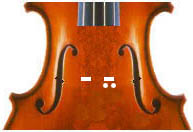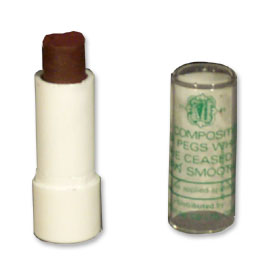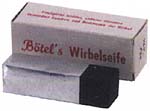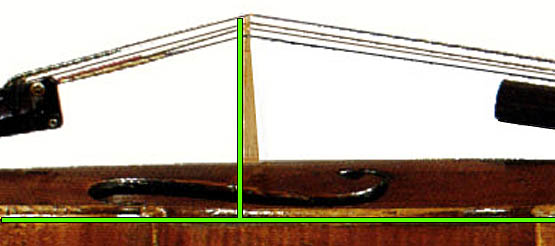| Lutherie, restoration and appraisals All string instruments Advice and opinion since 1963 Lutherie Paul Hostetter,
luthier Vaguely
related
Email:
click
here
|
Some general and helpful tips
about STRING INSTRUMENT CARE This is offered primarily for my local clientèle here by Monterey Bay, on California's central coast. If you stumbled upon this page from (or simply live) elsewhere, I hope you find it helpful. Heat is probably the #1 enemy of string instruments. Never leave an instrument in a parked car on a hot day. Avoid leaving it in a sunny room, particularly where direct sunlight might fall on it in your absence. Humidity—too much or too little—can be an issue as well, though coastal California is generally a very gentle climate, much more friendly toward string instruments than most other places on the continent. If you plan on traveling across the central valley on a hot day, or to the Rockies or the desert, first get some advice on how to deal with humidity and temperature. Taking care of the bridge A bridge should always be kept vertical and straight. It is a natural tendency of the bridge to tip forward as strings are tightened during tuning. Once a bridge has become bent through neglect, the cell structure of the wood is crushed and the bridge is permanently damaged. A little bit of regular attention will prevent this damage and the need to replace it. This applies to any bowed string instrument—violin through string bass. A well-maintained bridge will last generations.
It is essential that the bridge feet make 100% complete contact with the top - and not be tipped on an edge. The other critical adjustment is the placement of the feet of the bridge. Depending on the instrument's history, this will usually be in one of two standard places:
1) Ideally, the
backs of the bridge feet should rest against an
imaginary line drawn between the two inside nicks of
the f-holes. Since it is done with strings at full tension, adjusting the foot placement and verticality of a bridge requires some caution and skill. In either case, a side-to-side adjustment must first ensure that the strings are well-centered over the fingerboard. Great care must be taken to not allow the bridge feet to slip suddenly, or to allow the bridge to flop over. To adjust a violin or viola bridge, the instrument should be placed in the lap, scroll pointed away from you. Grip the base of the bridge firmly between the thumbs and middle fingers of both hands, and adjust the top gently with the index fingers. Ordinarily this involves gently nudging the top of the bridge back toward the tailpiece. With cellos and basses, the string tension is rather great - though with care the average player can straighten a cello bridge as follows: with the instrument lying safely on a soft surface, grip the top of the bridge with thumb and fingertips at the top, by each string, and tug it back gently but firmly, a little bit by each string, one then another, over and over until the bridge is again vertical. If the feet of the bridge fit properly, they will be snug on the top when the bridge is straight up. If something doesn't
seem right, or you're not certain you can deal with
it, get some help. See a competent violin luthier, or
ask your teacher for help. Bridges are expensive to
replace, so preventive maintenance is a good
idea.  The soundpost is a small spruce dowel that transfers sound from the top, near the treble foot of the bridge to the back. Its primary purpose is to carry vibrations from the bridge to the back, which is a resonating surface. Where the post is positioned, and how well each end of it fits the interior surfaces it touches, have a major effect on the tone of an instrument. Fitting, installing and adjusting a soundpost is a job for professionals. The two white dots on the sketch above indicate the range of normal locations for a soundpost. If the soundpost ever drops, get an experienced luthier to set it back right for you. Loosen the strings a bit, but leave enough tension to keep the bridge in place so the tailpiece is kept away from the face of the instrument. Bows
Pegs can be vexing for many, either because of real problems or because of the technique applied in actually using them. Pegs are tapered, and
must contact the insides of the holes on both sides of
the pegbox. The fit is very important, of course, as
is the nature of the contacting surfaces there. Raw
wood on raw wood never works well, so a preparation is
usually applied to facilitate a smooth turning of the
peg. A couple of commercial preparations are advised,
although some luthiers make their own "peg dope" from
scratch. I usually use Hill's, liberally applied.
Sometimes I need to chase that with Bötel's Wirbelseife, which
looks for all the world like a cheap black crayon. 
 Liquid peg drops and numerous other peg preparations, particularly the dreaded and desperate chalk and/or soap, really don't work well. Assuming the surfaces are making good contact, and assuming you have the right type and amount of peg dope on them, the real issue is how the peg is turned. You can't just turn it and expect it to stay put. Rather, you must press in on it as you turn the peg, to make sure the bearing surfaces remain properly engaged. Only then will it stay and not slip. Imagine that you are screwing the peg in as you turn it. Don't press too hard, of course, or you might crack the pegbox. If you need to, you can prop the instrument vertically in your lap and, holding the opposite side of the pegbox with one hand (to take the strain off the neck joint), press in and turn the peg with the other. Always tune up to a note, never back off to the correct pitch. Start below, tune up and push in a bit as you turn. If the peg seems to pop out, especially when it's been sitting in a case not even being played, it probably has to do with temperature change and the quality of contact of the bearing surfaces. Check two things: 1) if the peg is old, as in many pre-WWII instruments, it may have the old 20:1 taper which is prone to popping, particularly with temperature changes. There's not much to do short of repegging with the more modern 30:1 taper, which deals well with this problem. Old pegs had a more pronounced taper than modern pegs. 2) see if the peg is making good contact all the way around at both sides of the pegbox. Good contact is indicated by an even, shiny, burnished surface, 360 degrees, where wood meets wood. Pegs, being made of wood, naturally tend to shrink across the grain as they get old. Pegs can thus become oval in section with age, meaning they no longer contact fully all the way around. Sometimes oval pegs can be babied along a bit, but usually it's best to start over. If the pegs are slipping, and you can't figure out why (or even if you can), the best thing to do is get a qualified luthier to check it out and deal with it. Pegs must be fitted, meaning the raw peg is ground in a shaping device (a bit like a pencil sharpener) to make it just right, and fitted to a perfectly matching hole. This requires tools few players own or know how to use. Perhaps you need to work a bit on your technique of using the pegs too. Practice makes perfect. Strings Each instrument is different, and each player has individual tastes as well. These are therefore general remarks. It is generally agreed
that gut and perlon-type strings sound best on violins
and violas. They are certainly the most popular with
players regardless of musical styles. Many players
like Pirastro Eudoxa, Oliv and Gold Label gut
strings. Perlon strings
are essentially synthetic gut strings. Recommended
brands include the perennial favorites Thomastik
Dominants, though a dizzying number of variants on
this type of string are now on the market: Zyex,
D'Addario Pro Arté, and Pirastro Tonica or Aricore,
and Savarez Crystal. A newer hybrid, the D'Addario Helicore, has many devotées, particularly among violinists, violists and bassists (I don't know why it's taking so long for cellists to catch on). Many violinists prefer
aluminum-wound E strings (as opposed to plain steel
ones) because they sound less bright and shrill. These
wound Es are often called "non-whistling" E strings.
Look for them. Many players prefer real gut strings, Pirastro Eudoxa, Oliv and Gold Label, for example. Violists often prefer a steel A string in combination with perlon or gut lower strings. Note: wire-type mutes tend to damage perlon and gut strings and are not recommended for this reason. Stick with the rubber Tourte mutes. Many cellists prefer straight steel sets: Jargar (very fragile, but many feel they have the best sound), Pirastro Chrom-Cor and Thomastik Spirocore and Precision are popular brands, each with a little different sound. Larsen makes a very popular steel string for cello, also very fragile and very expensive. Also, coincidentally, from Denmark! A good alternative to Larsen and Jargar strings are Chrom-Cor Plus (a bit different than plain Chrom-Cor). A number of cellists prefer A & D in steel, and the G & C in gut or perlon. No two instruments are the same, nor are players all alike. It just takes awhile to find out what works best. Bass strings: Thomastik Spirocore remains the old standard, though many bassists have enthusiastically switched to D'Addario Helicores. Again, there are many different strings on the market because there are so many people with different instruments and different tastes and requirements. Super-Sensitive and Prelude strings are not recommended for any instrument. You get what you pay for. They're cheap and they sound bad. All bowed instruments When changing strings,
always change them one at a time, to ensure
that the soundpost inside the instrument is not
allowed to fall. And check the bridge for shape and
verticality afterwards. See above. Violins and violas Make sure that fine tuners don't ever touch the top of the instrument, which can happen on some instruments when the tuner is fully tightened. The levers can contact the top of the instrument, causing buzzing, putting the other strings out of tune and damaging the face of the instrument. Cases There is no substitute for a sturdy, well-fitting case. Using a case blanket or a cloth to lay over the face of violin or viola in its case is a very good idea. The piece of cloth can be used to wipe off excess rosin and so on - always a good idea. It also serves to protect the face of the violin from the bow, the bow holder and from things that may have somehow mysteriously come loose inside the case. Hard cases for cellos are extremely vulnerable in a vertical position. Avoid a broken neck and always leave these cases laying on their side while unattended. At home, a bungee cord and some hooks can make possible storing the case vertically, to save space. Never leave a cello or a bass resting vertically against a wall. They will likely fall, and the neck or scroll may break off. Or worse. I deal with this ten times a year, and it's completely preventable. Lay basses and cellos on their side when not in use, if you don't have a good commercial stand for them. If you are renting an instrument, do-it-yourself repairs are never appropriate. Always consult the rental shop in the event of a problem or a question. Likewise, when replacing strings on a rented instrument, always use the same strings with which it was provided. Questions? Have I forgotten something? Please let me know: Paul Hostetter,
luthier Support your
local music store if you still have one. I work out of a small shop next to my home in the coastal hills of central California. I work only by appointment. If you have any instrument-related question, by all means, please get in touch.
(Perhaps this is me, I
often feel like this) This page © 1998-2018 Paul Hostetter. All rights reserved. |





